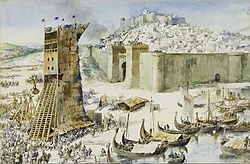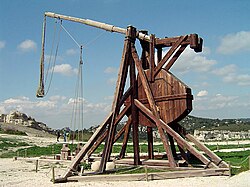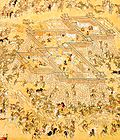Siege
| Part of a series on |
| War |
|---|
A siege is a military blockade of a city or fortress. The purpose is to conquer by starvation, lack of water, or by a well-prepared assault.
Siege warfare is a form of constant, low-intensity conflict. The defender inside has a strong, static, defensive position. Negotiation between combatants is common.
A siege happens when the attacker gets to a city or fortress which cannot be taken by storm, and which refuses to surrender. Sieges block the supplies and reinforcements or escape of men. Siege engines, artillery bombardment, and undermining are frequent. Deception and treachery are common.
Sieges can be decided by starvation, thirst, or disease. This form of siege can take many months or even years, depending upon the size of the stores of food the fortified position holds.
Well known sieges were:
- Siege of Petersburg
- Siege of Yorktown
- Siege of Odessa
- Siege of Orleans
- Siege of Fort Zeelandia
- Siege of Leningrad
- Siege of Tobruk
- Siege of Vicksburg
Siege Media
Depiction of the 1147 siege of Lisbon, painting by *Alfredo Roque Gameiro (1917)
The siege of Rancagua during the Chilean War of Independence, painting by Pedro Subercaseaux
The Egyptian siege of Dapur in the 13th century BC, from Ramesseum, Thebes
Depiction of various siege machines in the mid-16th century
Medieval trebuchets could sling about two projectiles per hour at enemy positions.
Cahir Castle in Ireland was besieged and captured three times: in 1599 by the Earl of Essex, in 1647 by Lord Inchiquin, and in 1650 by Oliver Cromwell.
Chinese and Korean troops assault the Japanese forces of Hideyoshi in the siege of Ulsan during the Imjin War (1592–1598).









